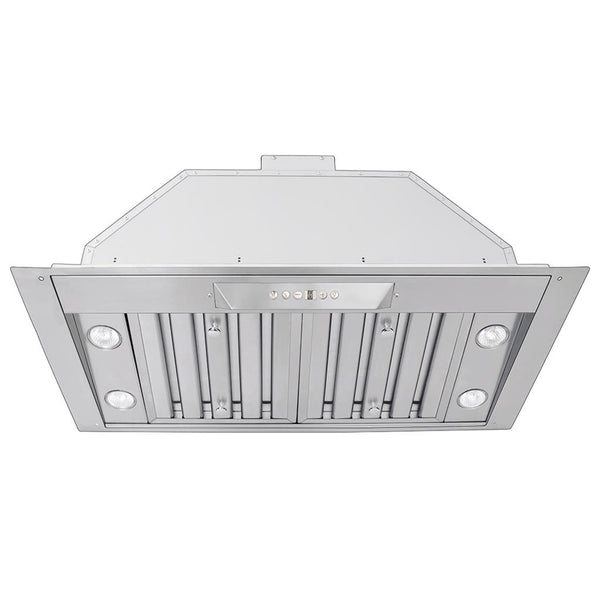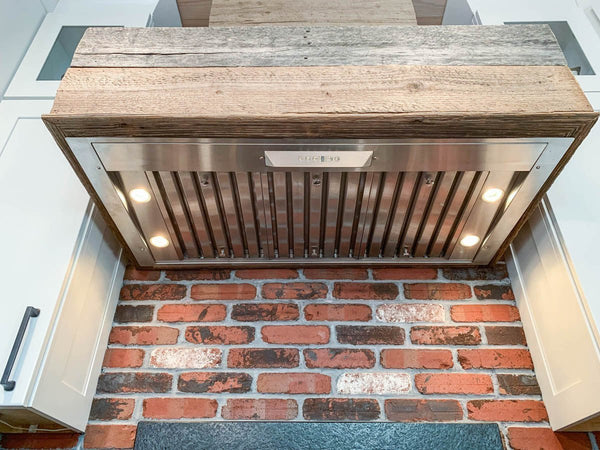Table of Contents
Installing a range hood in a kitchen with a sloped ceiling can be a real head-scratcher, but don't worry - we've got you covered. In this article, we're going to walk you through the common obstacles you might face, as well as share some handy tips and clever workarounds to help you nail that installation.
Let's dive in and make your cooking space both functional and fabulous!
Understanding the Challenges

One of our customers recently ran into a familiar challenge when trying to install a range hood in their kitchen with a sloped ceiling. The tricky part was getting the vent hood's chimney trimmed just right to seamlessly match the angle of the ceiling.
Nailing that precision cut is crucial - it ensures the range hood not only functions properly, but also blends in with the kitchen's design. But as this customer found out, that perfect cut is easier said than done.
Unfortunately, the cut they ended up with left a noticeable gap between the hood and the ceiling, which really threw off the overall look they were going for. And to make matters more complicated, this homeowner didn't want to rely on the usual fix of using crown molding to conceal those kinds of imperfections.
This experience really hits home for many homeowners. Trying to fit essential appliances like range hoods into kitchens with unique architectural elements, like slanted ceilings, can be a real headache. It just goes to show the need for clever solutions that can blend function and style to craft a kitchen that's both practical and aesthetically pleasing. It's all about finding that perfect balance.
Venting Configuration Considerations
You want to know where you are venting your hood before you plan the aesthetics of the project. When installing a range hood in a kitchen with a sloped ceiling, selecting the right venting configuration is crucial - it impacts both the functionality of the system and the overall aesthetic harmony of the space.
Through-the-Wall Venting
One option to consider is through-the-wall venting, which can be a more straightforward installation, especially in single-story homes or kitchens located on exterior walls. Since the ductwork has a shorter distance to travel to reach the outdoors, this can be a simpler solution. The challenge, though, is ensuring the exterior vent cover complements the home's facade, maintaining curb appeal and architectural integrity.
We have a full in-depth article on venting through a wall here.
Through-the-Ceiling Venting
On the other hand, venting through the ceiling and out the roof is a common choice for interior kitchens or multi-story homes. This configuration may involve more complex ductwork to navigate attic spaces or between floors, but it can offer a cleaner look within the kitchen, as the ductwork is largely concealed. The key consideration here is making sure the ductwork is properly insulated and sealed to prevent energy loss and protect against moisture issues in the attic or upper floors.
We have a full in-depth article on venting through the ceiling here.
DIY Solutions and Tips

While professional help is often the best approach for complex installations like fitting a range hood to a sloped ceiling, there can be times when a DIY solution is both rewarding and effective.
One of our customers faced the challenge of an imperfect cut on their range hood, which was really detracting from the overall look of their kitchen.
But through some research and a bit of elbow grease, they discovered some handy DIY methods and tips to achieve a cleaner, more polished cut - even with the tricky sloped ceiling.
Achieving a Cleaner Cut
DIY enthusiasts, when it comes to cutting the metal for your range hood installation, proper tool selection is key to achieving a clean, professional-looking result. I recommend using a cut wheel attached to a rotary tool - this will provide the precision and control you need.
The most important thing is to take it slow and steady, allowing the tool to do the work without applying excessive force, which can warp or damage the material. After the initial cut, finish up by using a fine-grit sanding wheel or sandpaper to smooth out any rough edges. This will ensure the final cut is not only visually appealing but also safe to handle.
Now, I understand not everyone has experience working with metal. If that's the case, consider consulting a metal fabrication specialist. They have access to specialized equipment like water jets and laser cutters that can deliver amazingly precise cuts without compromising the material.
Installation Tips
When it comes to the installation itself, here are some key tips to keep in mind:
- Accurate measurement of the ceiling slope and meticulous planning of your cut lines are absolutely critical. Take the time to create detailed templates and mockups - visualizing the end result before making any cuts will save you a lot of headaches.
- Ensure your installation fully complies with all relevant building codes and safety standards, especially when it comes to the venting and ducting. Improper venting can create serious fire and indoor air quality hazards.
- Invest in specialized tools like metal-cutting saws and secure, rigid ductwork. Resist the temptation of shortcuts like flexible ducting, as these can accumulate grease and compromise the system's performance.
- Make cuts in small increments and frequently test-fit the range hood to achieve the perfect alignment. Going slowly and double-checking your measurements will help you avoid costly mistakes.
If you have limited experience with this type of project, don't hesitate to consult with professionals like HVAC experts or metal fabricators. Their guidance can be invaluable in ensuring the job is done correctly.
The key is to be honest with yourself about your DIY capabilities. While a hands-on approach can be rewarding, the investment in professional installation may be well worth it to guarantee a flawless end result and peace of mind.
Creative Adjustments for Sloped Ceilings
Kitchens with sloped ceilings can really present a unique challenge, especially when it comes to installing range hoods. But with a little creativity and a willingness to explore custom solutions, these architectural quirks can actually turn into opportunities for truly one-of-a-kind design. Our customers have come up with all sorts of clever ways to adapt and personalize their kitchen setups, making sure they nail both the functionality and the style.
Custom Modifications and Tailored Pieces
One effective strategy is going the custom route - commissioning pieces that are designed specifically for the space. That could mean getting a custom-made chimney, either from the range hood company or from a local sheet metal shop, that perfectly aligns with the slope of the ceiling, ensuring a seamless, snug fit that looks great.
For those worried about the visual disconnect a sloped ceiling can create, adding a decorative frame around the base of the chimney can be a real game-changer.
It acts as both a structural support and a stylish design element that ties everything together, whether you want it to match the cabinets or stand out as a statement piece. They could be fashioned out of any material but crown moulding is the most popular option.
Leveraging the Experience of Others
Drawing inspiration from others who have tackled similar challenges can also be super helpful.
We suggest making a cardboard template of their ceiling slope to use as a guide when cutting the new chimney piece. Talk about a simple but brilliant solution that saves time and money while ensuring the perfect fit.
One of the reasons we offer a telescoping chimney is it can be adjusted to accommodate the ceiling height, and is one less measurement and cut to make. This off-the-shelf but adaptable solution offered a more budget-friendly alternative that still delivered a sleek, seamless look.
Seeking Professional Assistance
Recognizing the complexities of customizing a range hood installation for a sloped ceiling, our customer wisely decided to enlist professional help. They decided to have a reputable contractor come in and work on it with them.
They were able to approach the installation with years of experience and a keen eye. They recommended a replacement chimney that would better suit the specific requirements of the space.
Taking the time and investing in custom-fitted components ensures the installation looks great and performs optimally over time.
In this particular installation, embracing professional assistance was the way to go!
Building Code and Safety Considerations
When customizing installations for kitchens with unique architectural elements, like sloped ceilings, it's crucial to make sure any adaptations still meet local code standards. Failing to do so doesn't just carry legal consequences - it can also significantly increase the chances of serious hazards in your home from improper venting.
One such hazard is the use of flexible ducting, which is often prohibited in kitchen vent installations due to its tendency to accumulate grease and lack of durability.
Faulty venting paths can also lead to exhaust air being recirculated back into the home, compromising indoor air quality and potentially causing moisture damage and mold growth.
Conclusion
Installing a range hood in a kitchen with a sloped ceiling is no easy feat - it takes serious consideration of both practical functionality and aesthetic factors. Whether you decide to seek out professional help or tackle it as a DIY project, the key is understanding the common challenges, exploring creative solutions, and making sure everything meets all the necessary building codes and safety standards.
By addressing the unique architectural elements of your kitchen, you can achieve a range hood installation that not only performs flawlessly but also seamlessly blends in with the overall design. The goal is to strike that perfect balance of utility and style, making your kitchen a true reflection of your personal taste and the character of your home.
With the right planning, expert guidance (when needed), and a dash of creativity, you can transform the challenge of a sloped ceiling into an opportunity to showcase your kitchen's one-of-a-kind charm and functionality. Embrace the process, because the end result will be a cooking space that caters to both your practical needs and your design aspirations. It's all about finding that harmony between form and function.
Other Articles
Don’t Install Your Range Hood Until You Read This Ultimate Guide!
Determining the Ideal CFM for Your Outdoor Range Hood (From the Pros)
Does an outdoor kitchen need a vent hood?
Who to Hire for Flawless Outdoor Range Hood Installation
Cooking Fumes: A Hidden Health Risk?Need expert guidance? Feel free to give us a call.
Contact us











